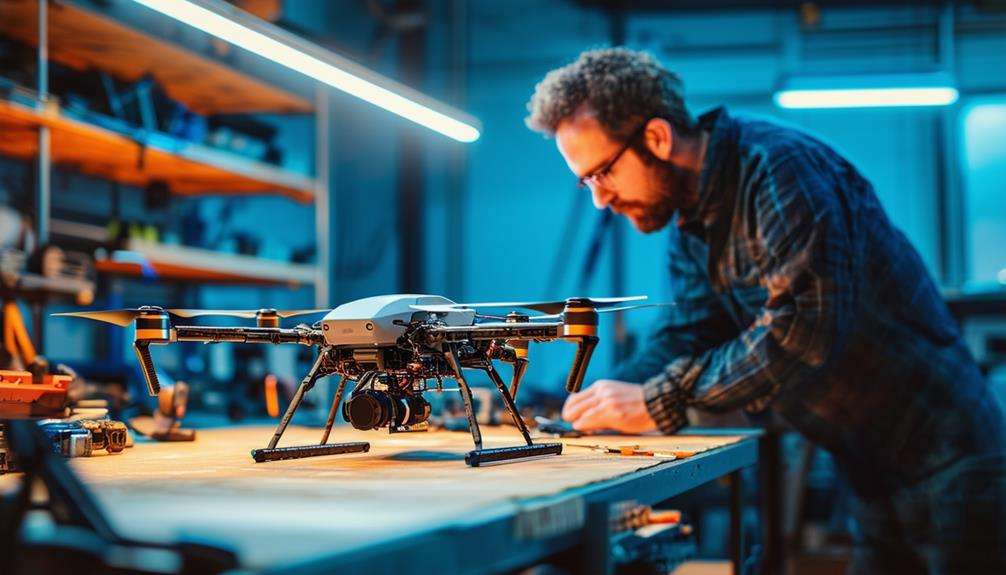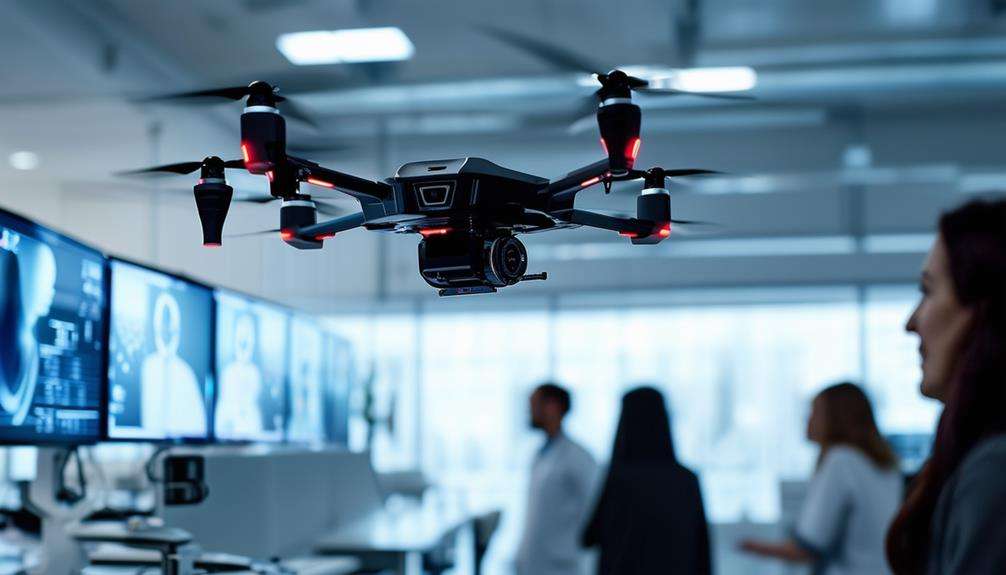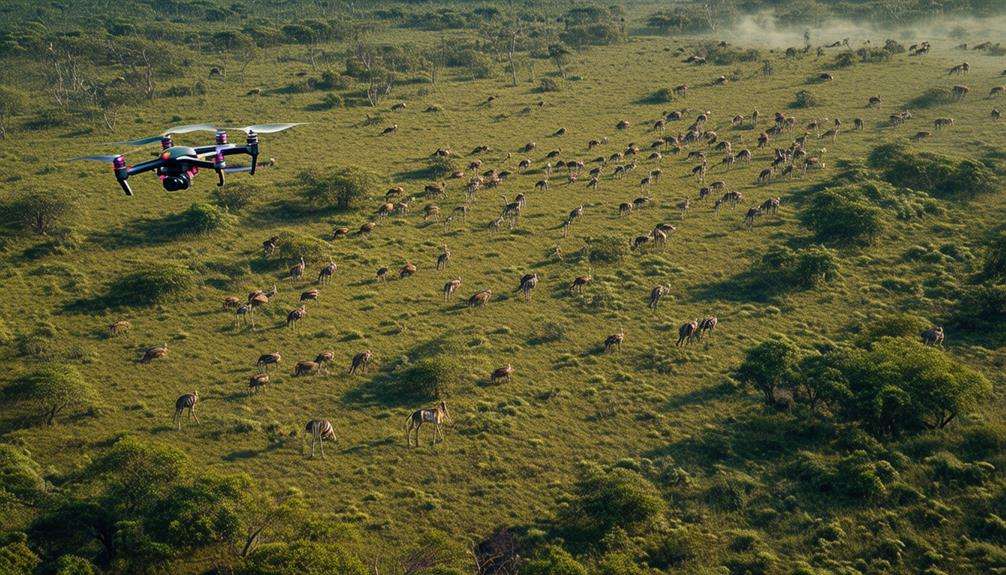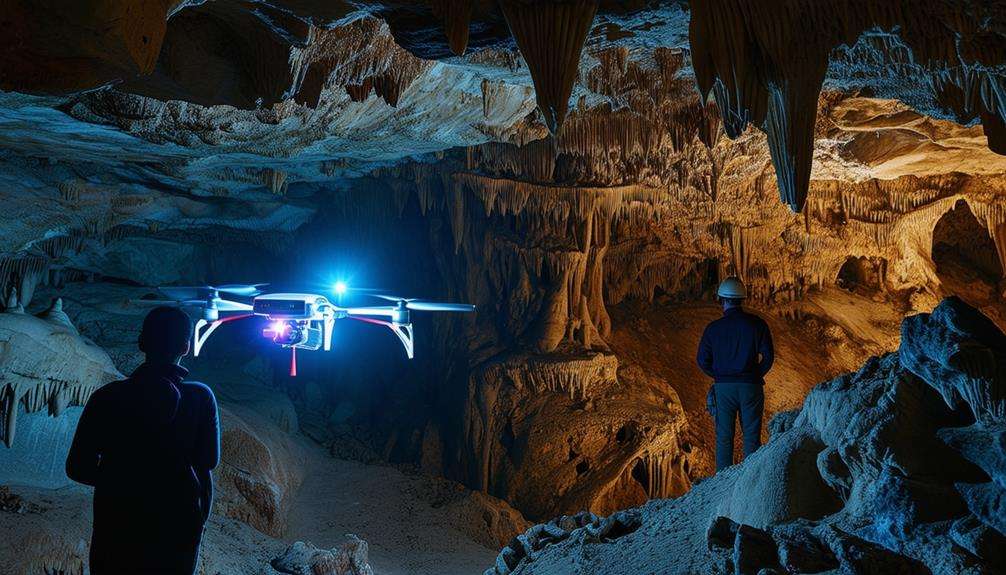How Far Can a Hobby Drone Fly?
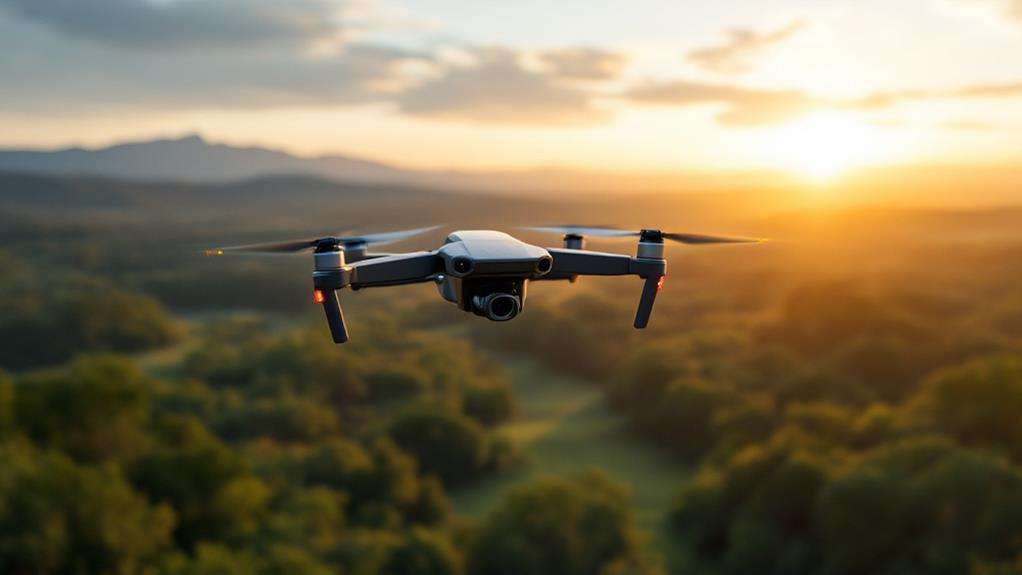
When exploring how far a hobby drone can fly, it largely depends on the type and specifications. Toy drones limit you to a few hundred feet, perfect for simple indoor fun. Entry-level consumer drones, ideal for starting photographers, reach 1 to 3 miles. High-end drones, with optimal conditions, stretch as far as six miles. Racing drones, designed for speed, cover 0.5 to 4 miles. Legal guidelines often restrict you to visual line of sight, around 0.25 to 0.5 miles. Many factors can boost or limit your drone's range. Discover how to optimize and understand your drone's full potential below.
Key Takeaways
- Hobby drones typically have a flight range between 1 to 3 miles, varying by model and conditions.
- High-end hobby drones can reach up to 6 miles under optimal conditions.
- Environmental factors like wind and temperature can significantly affect drone flight range.
- FAA regulations require drones to be flown within visual line of sight, usually limiting range to 0.25 to 0.5 miles.
- Signal boosters and higher-capacity batteries can enhance the flight range of hobby drones.
Factors Affecting Range
When it comes to the flight range of hobby drones, several key factors can influence how far your drone can travel. The drone flight range typically varies between 1 to 3 miles, largely depending on battery performance and the weight of the drone. Heavier drones, especially those with added accessories, will consume more power, which can limit their range. To maximize the distance, ensure your drone is as light as possible. Additionally, hobby drones can be equipped with multispectral cameras like those used in crop health monitoring, enhancing their capabilities beyond recreational use. Environmental factors also play a crucial role in determining your drone's flight range. Wind speed and temperature can significantly impact battery performance and signal stability. Flying in calm weather conditions helps you maintain a more consistent connection and better battery life. The type of remote control technology you use is another important consideration. Drones using advanced radio frequency technology generally offer a more extended flight range compared to those relying on Wi-Fi, which can be more susceptible to signal loss. Lastly, your flying style matters. Smooth flying styles instead of aggressive maneuvers help conserve battery life, allowing for an extended flight range. By considering these factors, you can optimize the performance of your hobby drones and enjoy longer flights.
Types of Hobby Drones
Understanding the factors affecting your drone's range is only the beginning. You'll also need to consider the types of hobby drones available. Each type offers distinct flight ranges and capabilities to suit different needs.
Toy Drones are a great starting point. With a range of a few hundred feet, they're perfect for indoor use and simple outdoor flying. Entry-Level Consumer Drones, like the DJI Mini series, extend your reach to 1 to 3 miles. They're ideal for casual aerial photography and exploration. Mid-Range Drones, such as the Holy Stone HS720, offer about 0.9 kilometers (0.56 miles) of flight, striking a balance between features and affordability.
| Drone Type | Flight Range |
|---|---|
| Toy Drones | A few hundred feet |
| Entry-Level Consumer Drones | 1 to 3 miles |
| Mid-Range Drones | 0.9 km (0.56 miles) |
| High-End Hobby Drones | Up to 6 miles |
High-End Hobby Drones, like the DJI Mavic Air 2, can soar up to 6 miles under optimal conditions, offering advanced capabilities for enthusiasts. FPV Racing Drones focus on short-distance racing, with ranges between 0.5 to 4 miles, prioritizing speed and real-time video transmission. Choose the right type to match your flying ambitions.
Legal Flight Restrictions
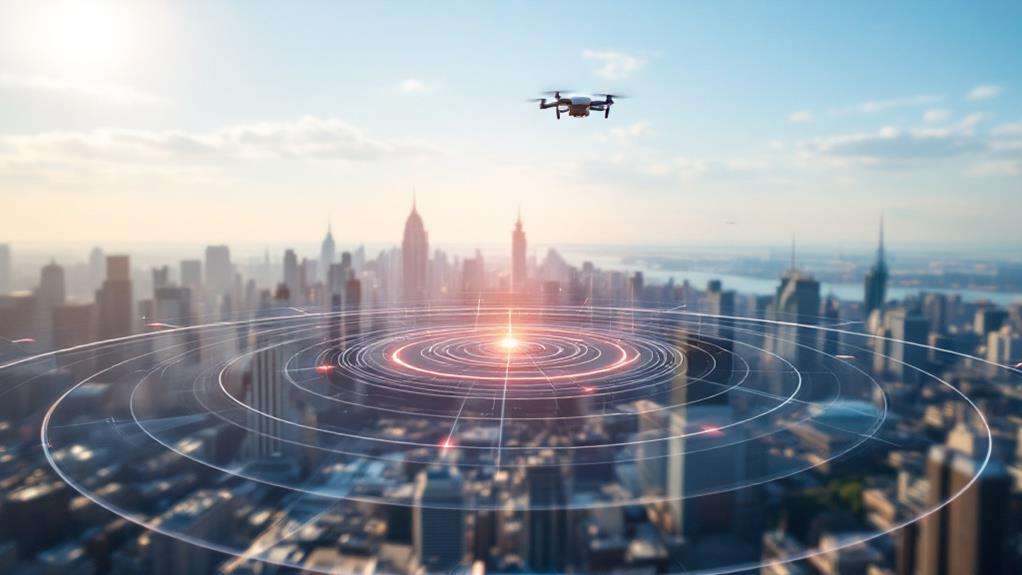
Navigating the legal landscape of drone flight is crucial for every hobbyist. When flying hobby drones, it's important to understand that FAA regulations require you to keep your drone within your visual line of sight (VLOS). This typically means you can only fly your drone between 0.25 to 0.5 miles away, ensuring that you can see it with the naked eye without any technological aids. These VLOS requirements are put in place to prevent accidents and ensure safety. Notably, the FAA's Part 107 regulations have established clear guidelines for drone operations, distinguishing between commercial and recreational flights. If you're thinking about flying beyond this flight range, you'll need special permissions. The FAA and other regional regulations demand strict compliance when it comes to flying beyond VLOS, especially in areas that are populated or sensitive. Not knowing these rules could lead to significant legal consequences, such as fines or even losing your drone.
Moreover, local laws can impose further restrictions, so it's vital to be aware of both federal and regional regulations. Understanding these legal parameters not only keeps you compliant but also enhances your flying experience by avoiding unnecessary legal issues. Stay informed and always prioritize safety when flying your hobby drone.
Enhancing Flight Distance
While adhering to legal flight restrictions is important, there's also a lot you can do to enhance your drone's flight distance. Start by upgrading to higher-capacity batteries, which can significantly extend your flight range. Some drones can fly for over 30 minutes when optimized. Reducing payload weight by using lightweight materials can further boost efficiency, allowing for longer distances without sacrificing performance. Additionally, consider high-efficiency propellers and optimizing aerodynamics to decrease energy consumption. These modifications can really make a difference in how far your drone can go.
Don't forget about the importance of maintaining a strong communication range. Employing signal boosters or high-gain antennas can help maintain connection between your drone and the controller, enabling flights over greater distances without losing control. Planning your flights around favorable weather conditions, like tailwinds, can also help you maximize your drone's potential by reducing battery drain.
Environmental Impacts
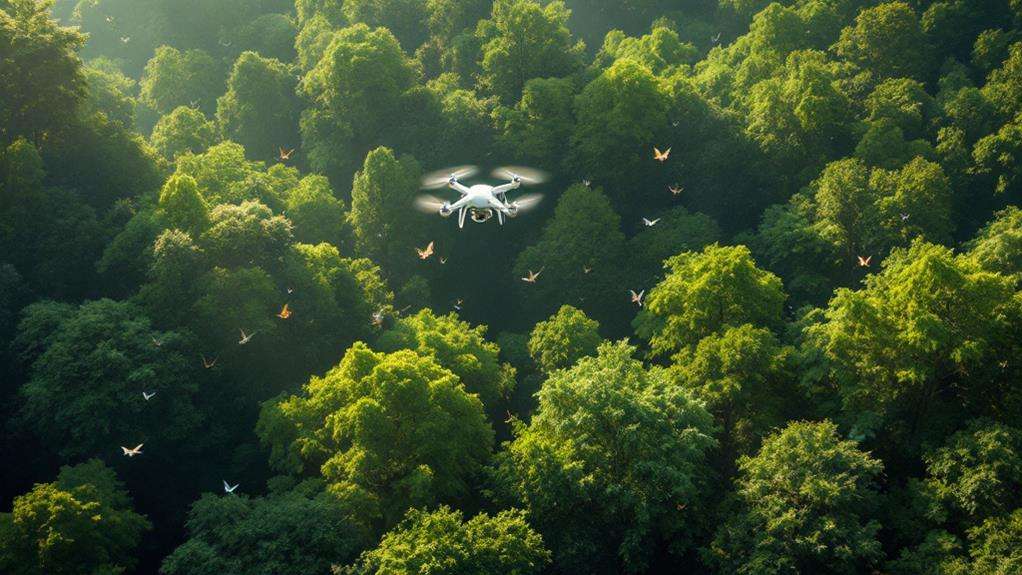
Environmental factors can greatly influence the flight performance of your hobby drone. You might find that the drone flight range is affected by various environmental conditions. For instance, wind speed plays a crucial role; most consumer drones can handle winds up to 15-20 mph. Beyond this, you'll likely experience decreased performance, impacting the operational range. Temperature extremes also affect battery efficiency. In colder climates, expect a 20-30% reduction in battery life, which shortens flight duration and range.
Rain and snow don't just pose a risk to your drone's electronic components; they also hinder stable flight, further limiting operational range. Altitude is another factor to consider. At higher altitudes, reduced air density makes it harder for drones to achieve lift, leading to increased power consumption and a shorter range.
Flying in urban areas introduces another challenge: electromagnetic interference. High levels of interference can disrupt signal transmission, causing a decreased operational range and risking control loss. To maximize your drone's capabilities, always consider these environmental impacts. Adjust your flight plans accordingly to ensure a safe and efficient experience, regardless of the conditions you encounter.
Drone Battery Life
When flying your hobby drone, understanding battery life is crucial for a successful flight experience. Drone battery life typically ranges from 20 to 30 minutes, depending on the model and how you use it. Most hobby drones come with lithium-polymer (LiPo) batteries, which strike a balance between weight and energy capacity to optimize flight time. The battery capacity, measured in milliampere-hours (mAh), directly affects how long your drone can stay airborne. Higher capacity batteries, like those with 3000 mAh or more, usually provide longer flight durations.
However, keep in mind that environmental factors such as temperature and wind can influence battery performance, sometimes reducing flight time under adverse conditions. Cold weather, for instance, can drain battery power faster, cutting into your flight time. That's why many hobby drones are equipped with smart battery technology, offering real-time updates on remaining battery life. This technology alerts you when it's time to bring your drone back, helping you avoid unwanted landings or crashes.
Monitoring your drone's battery life, especially in challenging environments, ensures you make the most of your flying sessions and return safely with your hobby drone in one piece.
Signal and Control Limits
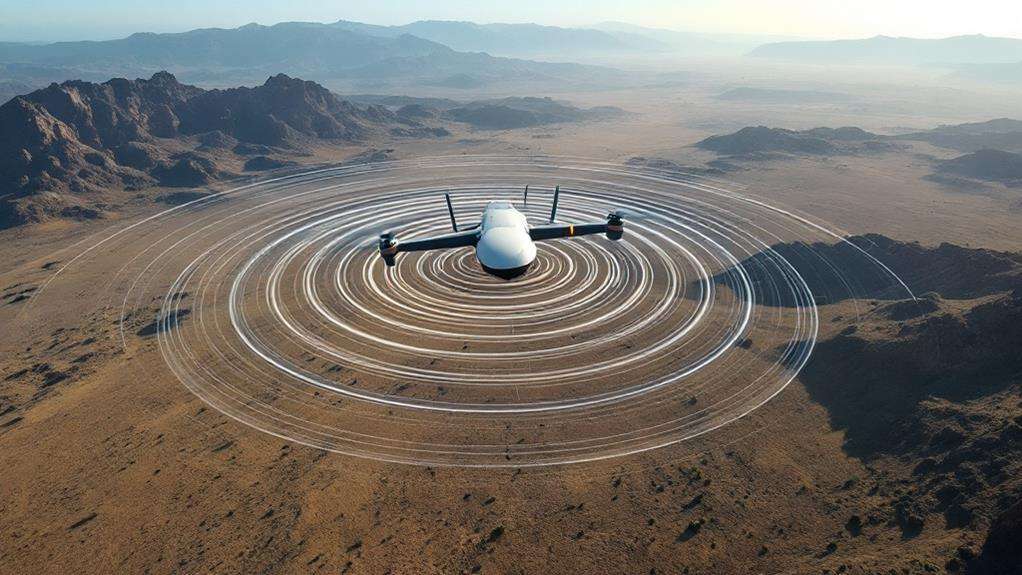
Signal and control limits play a crucial role in your drone flying experience, determining how far you can navigate your hobby drone before losing connection. The range of hobby drones typically spans from 0.5 to 3 miles, depending on the model and transmission technology. For instance, drones like the DJI Mini series can reach up to 4 miles under optimal conditions. The control signal often uses 2.4 GHz or 5.8 GHz frequencies. While 2.4 GHz offers a longer range, it's more susceptible to interference, whereas 5.8 GHz provides superior video quality but with a shorter range.
Environmental factors significantly impact your drone's operational distance. Maintaining a visual line of sight is crucial, as obstacles like trees or buildings and electromagnetic interference can disrupt signal transmission. Some hobby drones feature advanced communication systems, including signal boosters or antennas, enhancing control over longer distances. These systems ensure a stable connection, allowing you to maximize your drone's range.
To mitigate risks, many hobby drones come equipped with Return to Home (RTH) functionality. When your drone ventures out of range or loses signal, RTH activates, guiding the drone back to its starting point safely, thus preserving battery life and protecting your investment.

